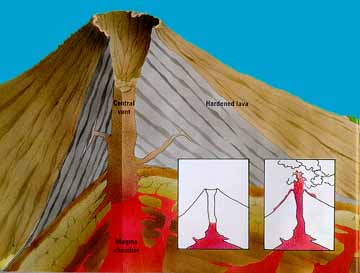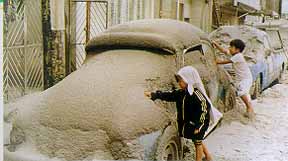
|
|
|
|
|
|
|
Volcanoes
The earth's plates float on hot magma, which is a mixture of melted rock and gases. The gases cause pressure to build up in the magma until it breaks through weak spots in the crust. When magma breaks through the crust, we call it a volcano.

When some volcanos erupt, hot lava comes out. Lava is what we call magma once it reaches the earth's surface. The Hawaiian Islands are made from volcanoes of this type.

The Hawaiian Islands have been forming for millions of years. There is a hot spot under the Pacific Plate where magma comes out and creates an island in the Pacific Ocean. Over the years, the plate has slowly moved, but the hot spot stayed at the same place. When it erupts, a new volcano forms that builds another island. Today, Loihi is growing over the hot spot.

There are other types of volcanoes that do not have a lava flow. This type of volcano erupts with hot gases, rocks, and ash. Vesuvius, the volcano that buried Pompeii, was one of this type. In our country, Mount St. Helens erupted with lots of hot ash that melted ice and snow, causing damaging mudslides to race down the mountain.


Mount Vesuvius was this type of volcano, burying Pompeii in a very short time. We read about this volcano in our literature book in POMPEII...Buried Alive. You can find out more about Vesuvius and Pliny, the boy who watched and wrote about the great explosion, in the Vesuvius link on the Volcanoes Hotlist.